|
|
|
Sort Order |
|
|
|
Items / Page
|
|
|
|
|
|
|
| Srl | Item |
| 1 |
ID:
183020
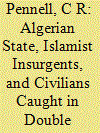

|
|
|
|
|
| Summary/Abstract |
During the Algerian Civil War of the 1990s responsibility for both targeted assassinations of prominent politicians and political activists and largescale massacres was frequently ascribed to both the government and the Islamic insurgents of the GIA. The same was true of the more mundane but much more numerous level of individuals who fell foul of both sides in the conflict and were frequently the targets of both. Using material from the asylum tribunals of several western countries this article describes how the widespread fear among the Algerian population was the result of the strategies of the government and GIA that both sought to intimidate, punish and exact revenge at a personal level leading to a widespread social dislocation.
|
|
|
|
|
|
|
|
|
|
|
|
|
|
|
|
| 2 |
ID:
138896
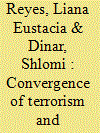

|
|
|
|
|
| Summary/Abstract |
This article examines the convergence among ethnic groups, narco-traffickers, insurgents, and terror organizations in Central Asia. It analyzes the lucrative business of drug trafficking and the diffusion of globalization, which have undoubtedly brought these once disparate groups together. It will explore how the increasing movement of illicit goods and people, proliferation of transportation technology, growing infrastructure, cooperative ethnicities, as well as a shared need for funding, have provided these groups with an opportunity to consolidate their efforts in ways that were not possible in the past.
|
|
|
|
|
|
|
|
|
|
|
|
|
|
|
|
| 3 |
ID:
109547
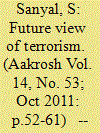

|
|
|
| 4 |
ID:
125247
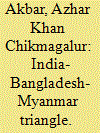

|
|
|
|
|
| Publication |
2013.
|
| Summary/Abstract |
India, Bangladesh and Myanmar are three neighbouring countries who along with sharing borders have also shared a colonial legacy under the British. They were controlled and administered from New Delhi and had stationed British officers and its Army at various posts. These three countries share the rich and fertile land of Brahmaputra basin where one of the largest rivers flows. They have similar geographical terrains, temperature, climatic conditions, soil, fauna and flora.
|
|
|
|
|
|
|
|
|
|
|
|
|
|
|
|
| 5 |
ID:
118506


|
|
|
| 6 |
ID:
122411
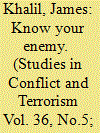

|
|
|
|
|
| Publication |
2013.
|
| Summary/Abstract |
Academics and military analysts regularly attempt to distinguish terrorists from insurgents through focusing on the extent to which these adversaries (a) adopt nonviolent methods, (b) apply uncompromising forms of violence, (c) generate local support, (d) recruit and maintain manpower, and (e) control territory. In contrast, this article argues that attempts to distinguish between these adversaries inevitably fail, firstly, as they arbitrarily impose binary distinctions upon continuous variables (e.g., in levels of support, manpower figures), and secondly as there is a lack of agreement across these supposedly identifying characteristics. Thus, contrary to common wisdom, it is concluded that there is no contradiction in simultaneously labeling groups such as the Taliban and Al Qaeda as both terrorists and insurgents. Indeed, a complete understanding of these groups requires an assessment of their activities at both the tactical (as terrorists) and strategic (as insurgents) levels.
|
|
|
|
|
|
|
|
|
|
|
|
|
|
|
|
| 7 |
ID:
115490


|
|
|
| 8 |
ID:
092308
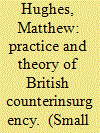

|
|
|
|
|
| Publication |
2009.
|
| Summary/Abstract |
This article details two largely unreported atrocities by British forces operating against Arab rebels during the Arab revolt, 1936-9, at the Palestinian villages of al-Bassa and Halhul. It then examines the military-legal system that underpinned and authorised British military forces operating in aid of the civil power, suggesting that the law in place at the time allowed for a level of reprisals and punitive actions, such as happened at al-Bassa and Halhul. The article does not conclude that the law allowed for atrocities but it does argue that it gave a basic form and understanding to an operational method that was brutal and could lead to atrocities. It thus tests the idea in much of the literature on counterinsurgency that the British were restrained and used minimum force when compared to other colonial and neo-colonial powers fighting insurgents.
|
|
|
|
|
|
|
|
|
|
|
|
|
|
|
|
| 9 |
ID:
087910
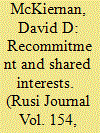

|
|
|
|
|
| Publication |
2009.
|
| Summary/Abstract |
The International Security Assistance Force (ISAF) has been engaged in Afghanistan for over seven years. The perception of a growing insurgency has caused some commentators and nations to question the mission, challenge the financial costs or become weary of the fight. Others believe the success of ISAF's strategy in Afghanistan is not only possible, but likely with the steadfast military, political and economic support of NATO and the international community. The Commander of ISAF, General McKiernan, argues for a recommitment by NATO to the goals of the mission, an acceptance of long-term responsibility, and a realisation that the solution requires more than just military means to secure the region.
|
|
|
|
|
|
|
|
|
|
|
|
|
|
|
|
| 10 |
ID:
119147
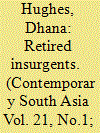

|
|
|
|
|
| Publication |
2013.
|
| Summary/Abstract |
This article explores the ways in which people who have perpetrated violence reformulate their lives and recreate sociality in the aftermath, through a focus on the narratives of former insurgents in Sri Lanka. It is anchored in a period of violence known as 'the Terror' (Bheeshanaya), which convulsed the southern and central regions of the country in the late 1980s. Attention is paid to how former insurgents go about recreating their social worlds in a post-terror context where 'perpetrators', 'victims', and 'witnesses' must live side-by-side in the absence of justice or reconciliation. This article suggests that for many 'perpetrators' of violence, rebuilding life in the aftermath is grounded in the mundane. The everyday that former insurgents must continually negotiate is saturated with the ethical charge of their past violence, which shapes sociality in the present in convoluted ways. Past violence and its complex moral evaluations linger beneath the everyday and surface unexpectedly under the most banal circumstances. Former insurgents reflexively put in place carefully thought-out strategies to re-create sociality and proactively attempt to manage the obstacles that their violent pasts may throw in the way of their ongoing attempts to reclaim their social worlds after terror.
|
|
|
|
|
|
|
|
|
|
|
|
|
|
|
|
| 11 |
ID:
121583
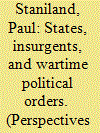

|
|
|
|
|
| Publication |
2012.
|
| Summary/Abstract |
Bargains, deals, and tacit understandings between states and insurgents are common in civil wars. This fascinating mix of conflict and cooperation shapes patterns of politics, governance, and violence. Building on recent findings about state formation, I offer a conceptual typology of political orders amidst civil war. Wartime political orders vary according to the distribution of territorial control and the level of cooperation between states and insurgents. Orders range from collusion and shared sovereignty to spheres of influence and tacit coexistence to clashing monopolies and guerrilla disorder. Examples from contemporary South Asian conflicts illustrate these concepts, which are scalable and portable across contexts. Scholars need to think more creatively about the political-military arrangements that emerge and evolve during war. A key policy implication is that there are many ways of forging stability without creating a counterinsurgent Leviathan.
|
|
|
|
|
|
|
|
|
|
|
|
|
|
|
|
| 12 |
ID:
134991
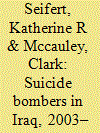

|
|
|
|
|
| Summary/Abstract |
Extending data reported by Mohammed Hafez in 2007, we compiled a database of 1,779 suicide bombers who attempted or completed attacks in Iraq from 2003 through 2010. From 2003 through 2006, monthly totals of suicide bombers show a pattern different from the pattern of non-suicide insurgent attacks, but from 2007 through 2010 the two patterns were similar. This biphasic pattern indicates that suicide attacks sometimes warrant separate analysis but sometimes are just one tactic in a larger envelope of insurgent violence. We also show that only 13 percent of suicide bombers targeted coalition forces and international civilians, primarily during the early years of the conflict, whereas 83 percent of suicide bombers targeted Iraqis (civilians, members of the Anbar Awakening Movement, Iraqi security forces, and government entities) in attacks that extended throughout the duration of the insurgency. These results challenge the idea that suicide attacks are primarily a nationalist response to foreign occupation, and caution that “smart bombs” may be more often sent against soft targets than hard targets. More generally, our results indicate that suicide attacks must be disaggregated by target in order to understand these attacks as the expression of different insurgent priorities at different times.
|
|
|
|
|
|
|
|
|
|
|
|
|
|
|
|
| 13 |
ID:
100869
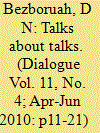

|
|
|
| 14 |
ID:
131896
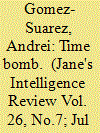

|
|
|
|
|
|
|
|